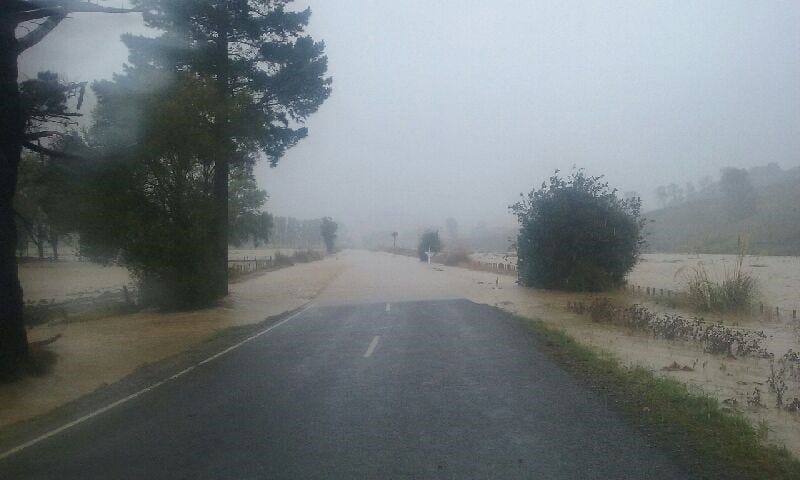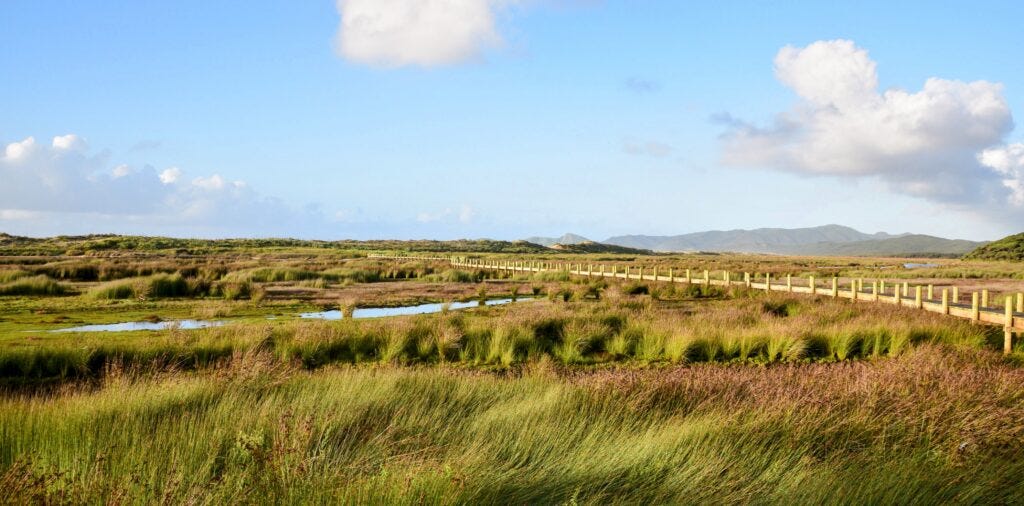This guest post by Dr Stuart Donovan looks at how strengthening the urban core can turn liabilities into assets. The header image of Rangiwhakaoma is by the author.
I recently travelled to the remarkably picturesque coastal settlement known as Rangiwhakaoma (Castlepoint), which translates loosely to “where the sky runs”.
Perched precariously on the east coast of the Wairarapa around 60km by road from Masterton, Rangiwhakaoma boasts a resident population of approximately 60 people. As I drove, I reflected on the infrastructure connecting Rangiwhakaoma to the world. The road, for example, traverses slippy hills and floody rivers and is hard to keep open.
Google Maps showing the 60km road from Masterton to Castlepoint/ Rangiwhakaoma.
Flooding on Masterton Castlepoint Rd. Photo by Steve Rendle via Wairarapa Times-Age:
To understand the costs incurred in providing infrastructure to remote settlements like Rangiwhakaoma, I ran some quick sums on the relativities involved. New Zealand’s road network is around 90,000km for a population of 5.3 million people, which equals about 17m of road per person. Similarly, there about 170,000km of electricity transmission and distribution lines in the country, which works out about 32m per person. So, on a pro rata basis, the 60 residents of Rangiwhakaoma are entitled to a “fair share” of about 1km of road infrastructure and 2km of power lines. Sadly, this isn’t enough to get out of the settlement itself, let alone 60km to Masterton.
And places like Rangiwhakaoma aren’t exactly uncommon. From Kawhia to Wharariki, New Zealand is sprinkled with small settlements sitting at the end of long infrastructure connections that are vulnerable to extreme weather events and other natural disasters.
Wharariki beach image by Régis Mathey via Flickr (CC BY-NC-SA 2.0)
Is this really a problem? Well, it depends. To understand why, I think it’s helpful to draw on some basic economic concepts. To start, let’s split the costs of providing infrastructure into fixed and variable costs. Fixed costs are those incurred in ensuring infrastructure is available regardless of how much it’s used whereas variable costs are those incurred in the use, or consumption, of the infrastructure.
For places like Rangiwhakaoma, it’s the fixed costs that dominate the equation due to their small size.
And, in my experience, people regularly underestimate the fixed costs involved in providing infrastructure. Take a look, for example, at the “fixed daily charges” on your utilities bill, which capture the costs of renewing and maintaining transmission and distribution networks. For example, we currently pay $1.20 and $1.76 per day for electricity and gas, respectively, which together make-up approximately one-third of our bill (NB: Our fixed daily charge for electricity is set to increase significantly over time).
These daily charges, however, are averaged across the whole network: The costs of providing infrastructure to small and remote places will be much higher. Drawing on the relativities above, for example, the fixed costs of providing electricity to Rangiwhakaoma could well be 15 times the network-wide average, or a cross-subsidy of $5,000 per dwelling per year (15 x 365 x $1.20 - 365 x $1.20). And this is just for electricity – adding transport and communications could well push up the cross-subsidies to $10,000-$20,000 per dwelling per year. This represents quite a large, ongoing financial liability.
So, what should we do about managing this liability? Well, I see two main ways to reduce the impacts of this liability. The first way is to strengthen price signals, allocating the fixed costs of infrastructure to those who benefit from it. This would likely result in lower fixed charges in more urban areas and much higher fixed charges in remote areas. Stronger price signals are nice in theory, but hard in practice for three main reasons:
First, people have already made decisions about where to live based on the current charges, so drastic changes to charges seems somewhat “unfair”.
Second, many small and remote places are relatively socioeconomically disadvantaged, so increasing fixed charges will be regressive or “inequitable”.
Third, higher fixed charges may cause (already small) populations to decline further, triggering a “doom loop” that doesn’t end up raising revenue.
Unless we’re ultimately willing to cut off infrastructure to some of these places altogether, stronger price signals seem to incur considerable pain for little gain (NB: I see more scope to strengthen price signals for variable costs and new development).
This brings us to the second and, in my view, more viable way to manage fixed costs: increased scale. Put simply, increased scale allows us to spread the fixed costs of infrastructure provision across more people, reducing the costs per person. Am I suggesting we should significantly boost the population of remote places like Rangiwhakaoma? Not necessarily, and – even if we wanted to – this outcome seems unlikely given the historical trajectory of population growth over the last few centuries.
We might, however, seek to boost the population in other, less remote parts of New Zealand. That is, strengthen our urban core.
To provide an example, let’s assume the fixed costs of providing road access to Rangiwhakaoma fall solely on the ratepayers of the Masterton District. According to some recent analysis, the population of the wider Masterton District is projected to grow by around 50% over the next three decades. All other things equal, we might expect this growth to reduce fixed costs per person by one-third (1.0/1.5).*
*Of course, this requires that we efficiently manage the infrastructure costs caused by urban growth, but I think this is within our capabilities and is a somewhat distinct topic that warrants its own discussion.
Nonetheless, this example highlights how growth in an urban centre, like Masterton, stands to benefit people in rural areas, like Rangiwhakaoma, by helping to spread the fixed costs of providing infrastructure over more people, thereby reducing the costs per person.
So, what’s the rub? To sum up my hypotheses:
New Zealand is home to many small and remote communities located at the end of relatively long and fragile infrastructure connections.
This geography often leads to quite high fixed costs in the provision, renewal, and maintenance of our infrastructure networks.
The fixed costs of sustaining infrastructure to these places are being cross subsidised by more densely populated parts of New Zealand (“the urban core”).
For reasons of fairness and equity, it’s difficult to see a viable path whereby price signals sheet home the fixed costs of infrastructure to remote areas. In which case the best way to mitigate the fixed costs is to try and spread them over more people and firms, typically by strengthening the urban core.
Naturally, the last hypothesis begs the question of what we might do to strengthen our urban core? While answers to this question are best addressed in a standalone post, I think recent speeches by the Minister for Housing and Urban Development, Chris Bishop, point to possible ways forward. Specifically, the Minister asked:
So, the question is, are we making the most out of New Zealand’s cities?
If we are honest with ourselves, the answer is no.
Quite often I experience ‘housing utopia whiplash’ – one article says, “don’t put intensification here, we need to protect the wooden villas”, another says “don’t do greenfield development, it contributes to more emissions”.
But if you can’t go up or out, you can’t go anywhere.
To make housing more affordable, our cities need to growth both up and out – we need bigger cities and, we need more houses.
In this speech, I think the Minister correctly acknowledges many of the benefits of enabling our cities to grow, e.g. via better planning and infrastructure policies. At the same time, I’d argue allowing New Zealand’s cities to grow also stands to benefit peripheral, rural areas, by spreading the fixed costs of infrastructure over more people.
This is why a little part of me dies every time I people raise trifling objections to urban development, like these recent examples from Auckland and Wellington.
Graphic by The Spinoff, on Auckland Council's rejection of a mass timber building for Karangahape Rd.
It’s not just that these developments deliver much-needed space in our cities, but also because strengthening the urban core helps to provide infrastructure in the periphery. The extent to which New Zealand’s urban core supports the provision of infrastructure in more peripheral locations is, I think, deserving of more attention and support.
Truth be told, places like Rangiwhakaoma are obscenely beautiful. And I’d suggest travelling down innocuously named winding roads to reach beautiful places is part of what makes living in New Zealand so very special. In this broader sense, places like Rangiwhakaoma, Kawhia, Wharariki, Anawhata, Matakana, Mimiwhangata, Waikawau, Okain’s Bay, and Aramoana etc aren’t liabilities at all. Rather, they’re tangible natural assets that serve to complement life in New Zealand’s urban areas. By adopting policies to strengthen New Zealand’s urban core, we can effectively reduce the costs of providing decent infrastructure to more small, remote, and oh so very special places.
Waitahora Lagoon at Cape Reinga. Photo by Stuart Donovan
About the author: Dr Stuart Donovan is a Senior Fellow at Motu Research. Stuart holds a PhD in urban economics and has two decades of experience working as a researcher and an advisor on infrastructure and land use policy.
Having recently returned to Aotearoa after a decade living in Brisbane and Amsterdam, Stuart enjoys spending his spare time sauntering around New Zealand and observing cultural encounters between his sassy Australian family and the generally more reserved and demure locals.
If you would like to learn more about the spatial and urban economic concepts discussed in this post, then please consider registering for a short course Stuart is running later this year.








There are some quite wrong assumptions regarding Castlepoint and infrastructure.
Firstly, the Masterton-Castlepoint Road serves a farming community which makes a major contribution to the Wairarapa's economy and employment. Farmers along this road pay a huge share of Masterton District's rates. Individual rate bills are eyewatering.
We had an annual plan meeting in Tinui last night with council members to discuss the next year's roading programme and rates increase (for farmers: 12%, for residents slightly less. )
The Masterton District Council has a very professional roading team who effectively managed difficult repairs from Cyclone Gabrielle in a geologically unstable area. With that work out of the way they have focused on putting improvements in that will mitigate against future storm damage. Everyone agrees this is a good idea, especially farmers.
The cost of roading to Castlepoint is met by farmers and property owners within the rural area. It is NOT subsidised in any way by Masterton urban ratepayers.
Where the system becomes unfair - and we talked about this last night - was :
(a) Forestry: 44 to 66 tonne logging trucks chew up our roads. If council imposes a bylaw making forestry companies or individual logging trucks pay for the damage, it is likely that the forestry companies will fight this all the way through court, leading to massive legal bills for the council.
(b) Thousands of tourists flock to our two beaches - Castlepoint and Riversdale Beach. They make no contribution whatsoever to our economy. A few stay in holiday accommodation and buy fish and chips in the store, but that's about it.
Good analysis, but some of the benefits of the infrastructure is for people who visit. Some of this is captured in GST, but general taxation doesn't entirely fund roads and power networks. Alternatively, a general bed levy might work.
Reducing the costs (per capita) by improving productivity is important, but finding better mechanisms for local funding is also part of the equation.